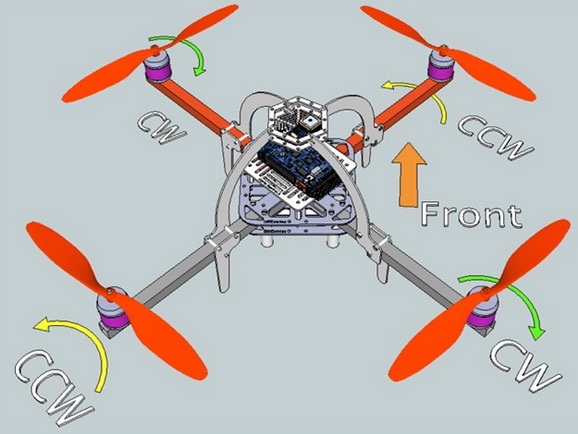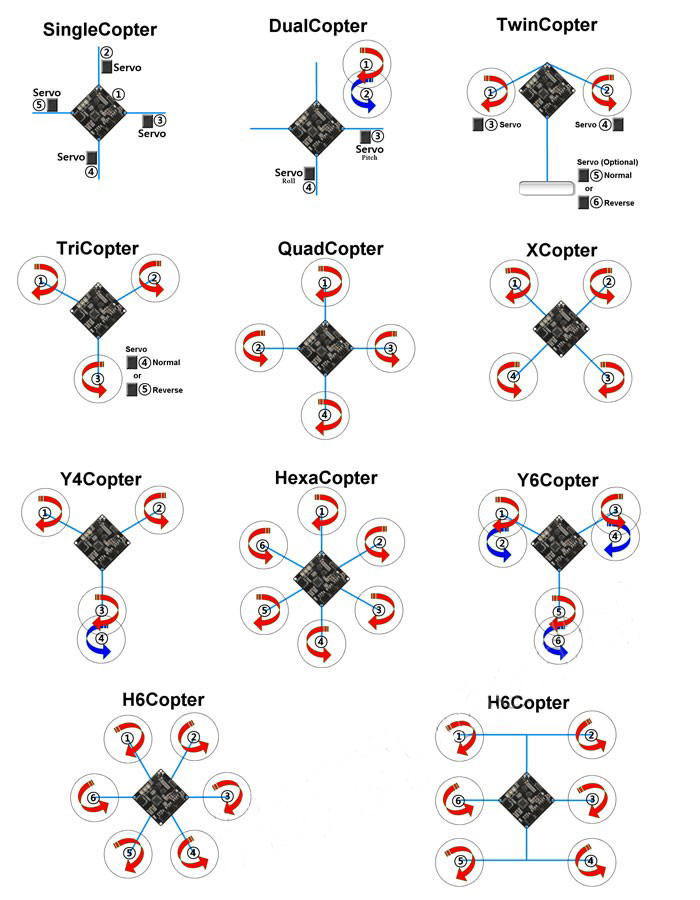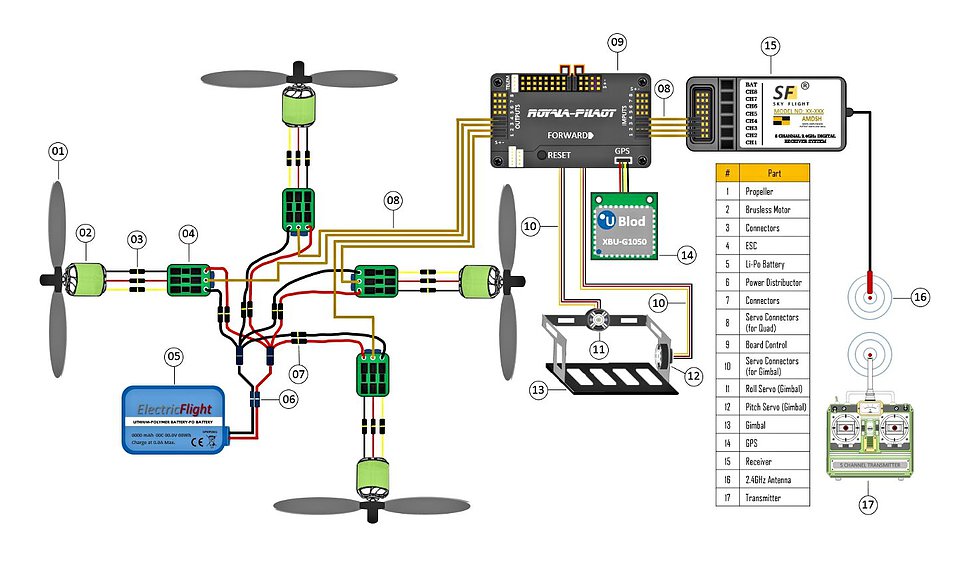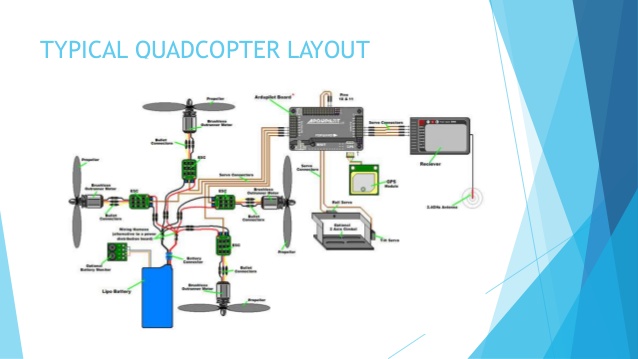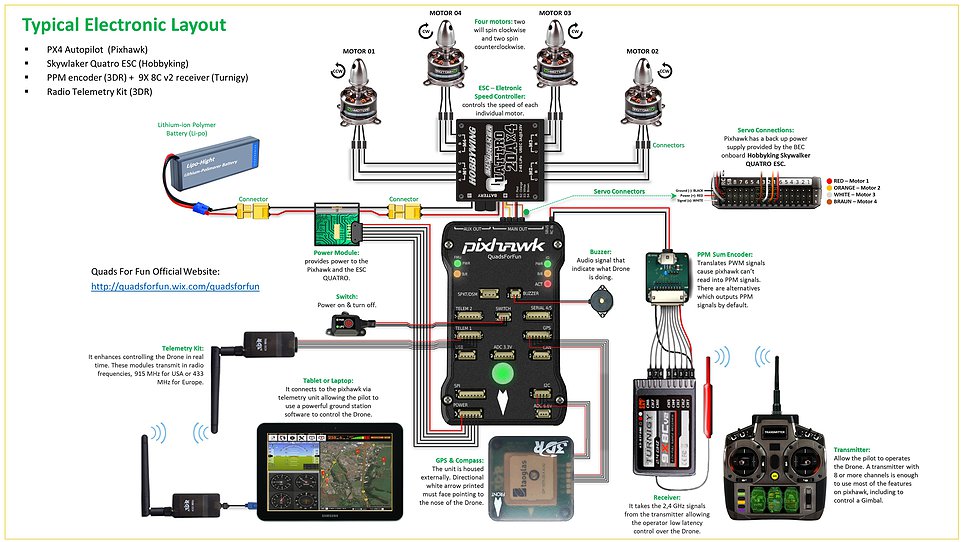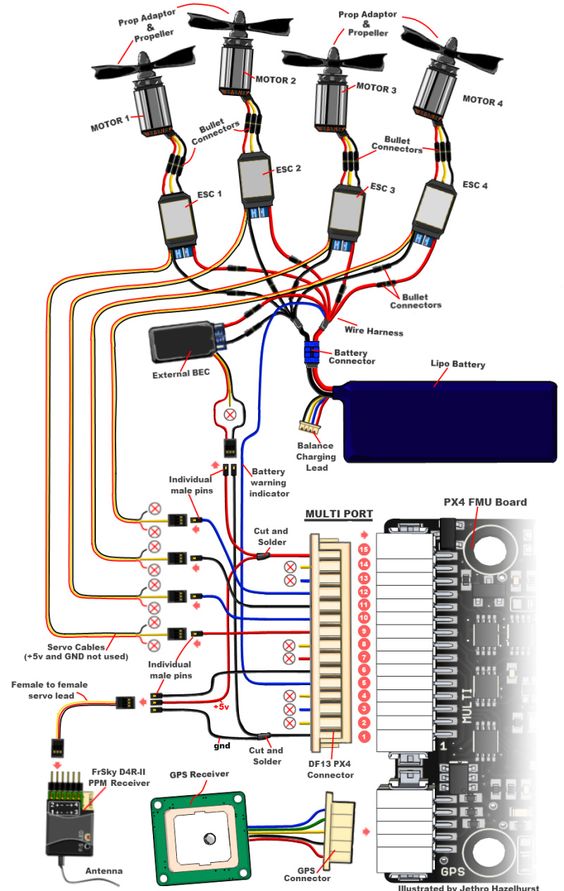- Brushless Motor
The Brushless motor selection dictates the whole power system of the quadcopter, therefore it should be carefully selected. The following items are the key drivers for selecting a motor.
- kV Rating
For multi-rotor application, a 600-1200kV motors are ideal and anything below 600kV is even better, as low kV rating translates to motor being able to handle bigger propellers, and bigger propellers means it can move more air which gets you more thrust.
kV = rpm/VDC
where:
kV is the motor rating (ratio of rotation speed against voltage)
rpm is the motor rotational speed (in rpm)
VDC is the voltage rating for the motor (in volts)
If you have 600kV motor and 3S LiPo battery to supply power, speed (rpm) of motor at no load would be 600 x 11.1(3S battery) = 6660 rpm.
- Maximum current
Max current rating is another important factor while selecting motor as the selection of ESC and battery depends on this value. The motor should be able to run on both 3S and 4S Li-Po battery.
- Shaft diameter
Shaft diameter helps you selecting propeller.
- Thrust
In a quadcopter, the In most cases, you will see value of the thrust motor can produce with suggested prop on the vendor’s website, but if that data is not available, try the Fly Brushless link.
If the lift required is 3000 grams, the quadcopter need to produce 2 to 3 times the thrust (ie 6000 grams thrust), leaving each motor requiring to produce about 1500 grams of thrust so that it will lift off the ground. This extra 2 times thrust is necessary to be factored into the calculation due to motor mechanical inefficiency, flight altitude and air temperature.
- Weight
To choose a motor we first need to how much weight you are planning to take, and then to work out the thrust required to lift the quadcopter. A general rule is that you should be able to provide 2 times as much thrust than the weight of the quadcopter. If the thrust provided by the motors are too little, the quad will not respond well to your control, even has difficulties to take off. But if the thrust is too much, the quadcopter might become too agile and hard to control.
Although you can choose the motors for the weight you want to carry, it’s always a good idea to carry as little weight as possible. Lightness is very important to all aircraft because any excess weight could reduce your battery life and maneuverability.
- Li-Po battery(3S-4S)
Batteries are selected based on the power requirements from the quadcopter electronics system
- Suggested propeller
The lift/thrust of the quadcopter is dictated by the rpm and the type of propellers that is selected. The two variables for an ideal propeller selection is the length and the pitch of the propellers.
Brushless motors are commonly used in RC. Brushless motors have three wires. These wires control the motor’s three phases. When connecting the motor to its ESC (Electronic Speed Controller), it doesn’t actually matter how you connect the wires to let it spin because you want two motors to rotate CW and other two to rotate CCW. So it is just by trial and error method you fix these wires.
The wire color is normally the same – red, black and white. If it has a J-Connector, the pinout for that brushless motor must be as follows.
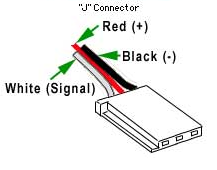
- Electronic Speed Controller (ESC)
ESC supplies power from battery to the motor but is not constant, it varies according to input signal. Essentially, the three-phased brushless motors are controlled by the Electronic Speed Controller (ESC). ESC also has BEC(Battery Eliminated Circuit). BEC is nothing but 5V output from ESC that can power up receiver, servomotor(for camera gimbal) and FC.
Generally, all ESC has three sets of wires.
- Power supply (two lower gauge wires – thick wires)
- Motor wires (3 lower gauge wires – thick wires)
- Signal wire (3 higher gauge wires 0 thinner wires)
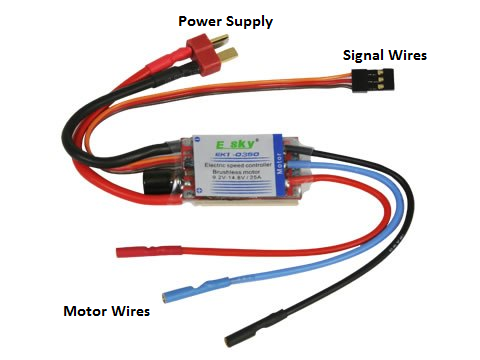
Note that there are a fully integrated 4 in 1 ESC system such as the “Q Brain 4 x 25A Brushless Quadcopter ESC 2-4S 3A SBEC” where 4 ESC is consolidated into one unit to keep wiring simple
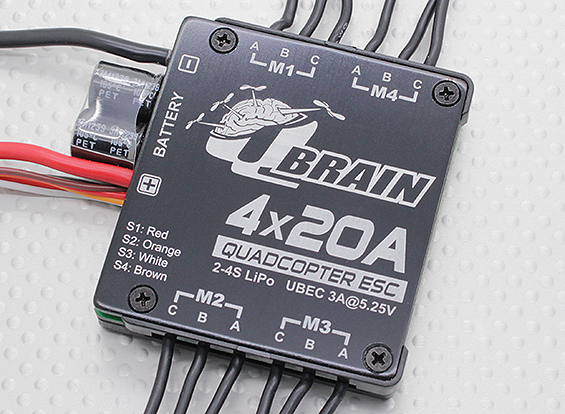
The general rule of thumb to keep in mind when selecting an ESC is that the current rating of ESC should be higher than max amp rating of motor – about 20% to 50% higher.
For example, if your maximum rating of your motor is 15amps, your ESC current rate should be between 18A to 23A
- Propeller
Propellers are classified by length and pitch. For example, 9×4.7 propellers are 9 inch long and have a pitch of 4.7.
Generally, increased propeller pitch and length will draw more current. Also the pitch can be defined as the travel distance of one single prop rotation. In a nutshell, higher pitch means slower rotation, but will increase your vehicle speed which also uses more power.

When deciding on length and pitch, you need to find a good balance. Generally a prop with low pitch numbers can generate more torque. The motors don’t need to work as hard so it pulls less current with this type of prop. If you want to do acrobatics, you will need torque propellers which provide more acceleration and it puts less pressure on the power system. Lower pitch propellers will also improve stability.
A higher pitch propeller moves greater amount of air, which could create turbulence and cause the aircraft to wobble during hovering. If you notice this with your quadcopter, try to choosing a lower pitched propeller.
When it comes to the length, propeller efficiency is closely related to the contact area of a prop with air, so a small increase in prop length will increase the propeller efficiency. (pretty much like swimmers with larger hands and feet can swim faster, but also more tiring for them)
A smaller propellers is easier to stop or speed up while a larger prop takes longer to change speeds (inertia of movement). In additional to that, smaller propellers draws less current, which is why hexacoptors and octocopters tend to use smaller props than quadcopter of similar size.
For larger quadcopters that carry payloads, large propellers and low kV motors tend to work better. These have more rotational momentum, and will more easily maintain your aircraft’s stability.
Key pointer of a propeller pitch
- Increase flight time on a heavier quadcopters by using a lower propeller pitch
- If you notice that the quadcopter wobbles a lot when hovering, it means that the pitch of the propellers is too high.
Key pointer of a propeller length
- If operating your quadcopter is too reactive (twitchy or hair trigger), then your propellers are too small or short.
- Large/Longer propellers with low
Key pointer of a propeller (in general)
- Large/Longer propellers with low pitch are ideal for aerial videography and photography.
- Smaller propellers with high pitch are ideal for fast quick maneuvers.
Note that there is a difference between a clockwise and counterclockwise propeller, and most of the part number reflects the propeller spin directions
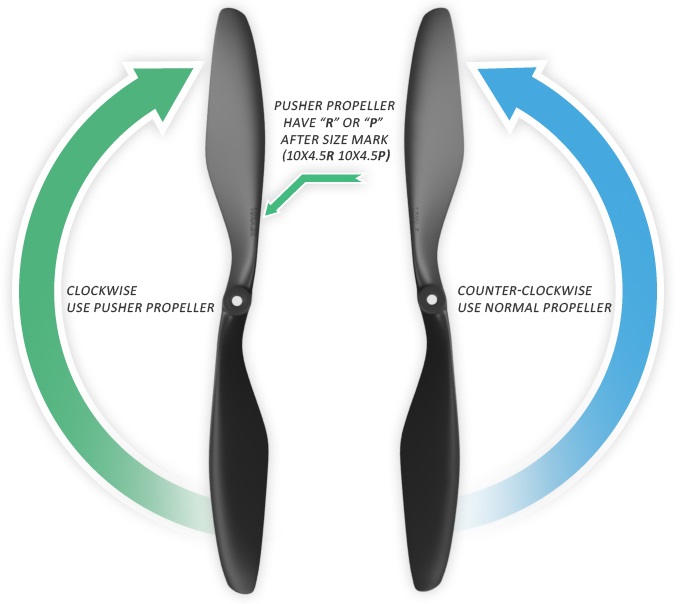
- Li-Po battery
Li-Po batteries provide high energy storage to weight ratios, are capable of fast discharges, and come in an endless variety of shapes and sizes.
It is is the “power house” (aka power supply) that allows a quadcopter to perform all your task that has been assigned or commanded. For that maximum current (amps) rating of motor comes first. If each of your quadcopter motor draws a max of 15amps, all 4 motors will draw 60amps (4 x 15amps = 60amps)- which will be your basis of your battery selection.
Here are some more explanations on what each of the battery specifications means
- mAh
This is basically the capacity of a battery. You can compare mAh rating of battery with gas tank of your vehicle. Bigger tank means more gas you can fill and more you can drive. In the same way, higher mAh rating gives you more flight time.
- C Discharge Rating
To start off with, the “C” in C discharge rating stands for capacity. Maximum current(amp) at which battery can be safety discharge at particular time, also known as peak or “burst” current discharge rating.
If you see 15C on your battery, it means it can be discharged at 15 times that pack’s capacity. Capacity refers to the milliamp-hour rating of the battery (as explained above), which will be listed as a number followed by mAh – for example 2000mAh.
For a 2000 mAh battery with a 15C rating, the continuous current that may be drawn out of the battery is 2000 mAh x 15 = 30000 mA, or 30 Amps (A) (divide by 1000 as it is in mAmps). This means that you can safely draw up to 30 amps continuously from that 11.1V 2000mAh 15C without doing damage to your battery.
- Battery types
The list below illustrates different types of battery configurations providing various voltages.
- 3.7 volt battery = 1 cell x 3.7 volts (1S)
- 7.4 volt battery = 2 cells x 3.7 volts (2S)
- 11.1 volt battery = 3 cells x 3.7 volts (3S) <== Commonly used in quadcopters
- 14.8 volt battery = 4 cells x 3.7 volts (4S) <== Commonly used in quadcopters
- 18.5 volt battery = 5 cells x 3.7 volts (5S)
- 22.2 volt battery = 6 cells x 3.7 volts (6S)
- 29.6 volt battery = 8 cells x 3.7 volts (8S)
- 37.0 volt battery = 10 cells x 3.7 volts (10S)
- 44.4 volt battery = 12 cells x 3.7 volts (12S)
Essentially, it means that 4S battery has more voltage(more power) than S3 battery, and so on.
Flashback to our power formula.
Watt = VDC x I
where:
Watt is power in watts
VDC is voltage (in VDC)
I is current (in amps)
We are increasing value of VDC, so the watt will be increased as well. If our motor draws max 15A, so the watt value for 3S and 4S will be as follows .
At 3S battery 11.1VDC x 15A = 166.5 Watt
At 4S battery 14.8VDC x 15A = 222 Watt
But make sure your motor and ESC are capable of handling 4S battery.
For our application, we know that we need at least 60A (15A per motor and 4 motors), and if we have to choose between these two batteries – 2200mAh 25C and 2200mAh 40C. Which battery would be good for our need? Lets see…
2200mAh is 2.2A
2.2 x 25C = 55A
2.2 x 40C = 88A
If we need at least 60A, 2200mAh 40C (which provides 88A of max allowable current draw) will be sufficient for our application.
The most common battery used for quadcopter application is 3S and 4S with nominal voltage of 11.1VDC and 14.8VDC respectively.
|
 Introduction
Introduction
